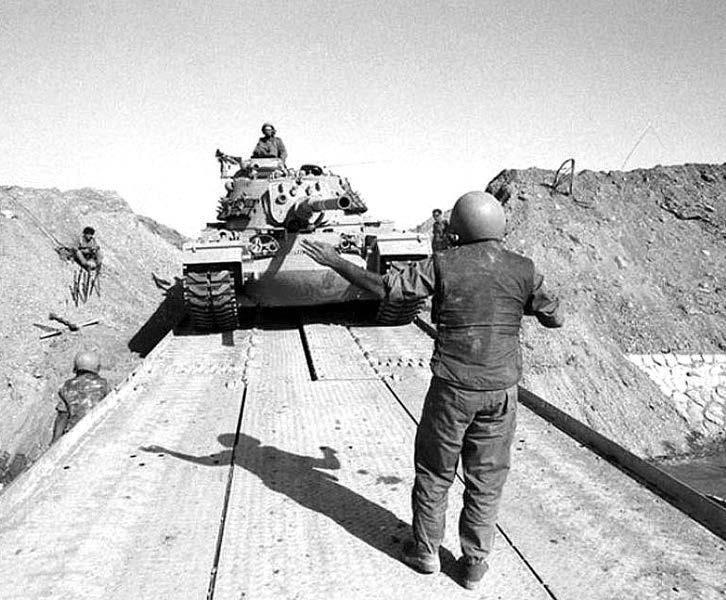
5 minute read
Forgotten Heroes
Forgotten Her es
Yom Kippur War Raids
Advertisement
By Avi Heiligman
Firing at targets on the northern front Egyptian President Anwar al-Sadat peering through a telescope in the Sinai Peninsula on June 4, 1973

The basic details of the Yom Kippur War are well known. A surprise attack on Yom Kippur, October 6, 1973, by an Arab coalition took the Israelis by surprise. Many soldiers were in shul – the Israeli intelligence had failed to pick up the impending attack. As reserves were called up and rushed to the frontlines and supplies were flown in from the U.S., the Arabs were making considerable gains on both the Suez front led by the Egyptian Army and the Golan Front led by the Syrians. It took Israel three days to fully mobilize its defense forces, and heavy fighting ensued on both fronts.
After a few days, the IDF managed to push back the Syrians and were shelling the outskirts of Damascus. The IDF also counter-attacked on the southern front and was making headway into Egypt before a ceasefire was imposed on October 25. The Israeli victory was bloody as over 2,500 Israelis were killed and over a thousand tanks and 100 aircraft were lost. In the middle of the conflict, raids were conducted by both the air force and Special Forces units that were designed to take off some of the pressure from the Israelis fighting on the front lines.
On October 9, the fourth day of the war, the IAF decided to carry out an aerial strike on Syrian headquarters in response to a surface-to-surface missile strike at the Ramat David Air Base the day before. The Israeli Air Force had suffered heavy losses in the first three days of the war, and this raid was designed to show the target, which was the Syrian General Staff Headquarters. Syrian air defenses failed to pick up the Israeli aircraft, and sirens only started wailing after the first bombs hit their targets. The headquarters was hit and forced the Syrians to move their operations much farther away from Israel. Two IAF Phantoms were hit during the
Syrians and the Jordanians that the IAF was still a very powerful force.
Major Arnon Lapidot led a formation of 8 F-4 Phantom fighter jets at low altitude over the Mediterranean to avoid radar detection. One jet had to turn back due to mechanical difficulties; the other seven planes reached Damascus over heavy cloud cover. A break in the clouds allowed the Phantoms to reorient themselves, and they headed for their primary raid and one pilot was killed. Although the raid received sharp international criticism, it had the desired effect of convincing the Jordanian king to not open a third front against Israel. Another raid of eight Phantoms was diverted to a Syrian tank column in the Golan Heights. They destroyed the enemy tanks, and Israeli forces were then able to push back the Syrian forces beyond the pre-war ceasefire line.
Operation Ketonet took place on October 12 north of Damascus. Soldiers from the 35th Paratroopers Brigade under the command of Major Shaul Mofaz were flown into deep Syrian territory by a CH-53 Super Stallion helicopter. Their objective was to ambush enemy columns from the Iraqi Expeditionary Force headed to the Golan Heights. After letting some vehicles pass, they attacked a pair of trucks and followed up with attacking more vehicles including a tank. Then they blew up an important bridge and moved to the extraction point. No Israelis were wounded or killed in the raid. The destruction of the bridge severely delayed the Iraqi forces from reaching the front lines.
Following the successful execution of Operation Ketonet, another force under Major Mofaz set out on another nighttime raid deep into Syria. Called Operation Davidka, the force of forty paratroopers was discovered by a Syrian patrol. They were able to avoid giving away their exact position due to not returning fire from the increasing number of Syrian troops. Mofaz split the group in two as they waited for helicopter extraction. As they regrouped on a hill, the Syrians pressed in from three
sides. The helicopter pilot Lieutenant Colonel Yuval Efrat landed despite taking heavy ground fire. All forty IDF soldiers scrambled aboard the chopper, and only one was slightly injured. After a head count, the CH-53 Super Stallion took off. After safely landing in Israel, the crew counted fifty enemy shells that had hit the chopper.
In the south, the fight against the Egyptians was intense as well and was also subject to raids by the IDF deep behind enemy lines. On October 15, the IDF launched an attack on the west side of the Suez and started to gain ground. The next morning, two companies of the 264th Battalion, 421st Armored Brigade were ordered to leave the main column and go on a raid deep into Egyptian territory. Their objective was enemy missile
An Israeli tank crossing the Suez Canal bases. The fast-moving Israelis only fought the enemy that got in their way while heading to the first missile base. Using cannon and machine gun fire, they destroyed the missile battery as well the radar facilities at the base. The column then moved on to another missile base that was abandoned. They then encountered an Egyptian force, and the Israelis destroyed some of the enemy vehicles. Two more missile bases were destroyed by the column. The fact that an Israeli force was operating deep behind the Egyptian lines rattled many Egyptian units. For a while, though, the Egyptian high command did not know an IDF unit was rapidly destroying three missile bases. In addition, the Israeli took out dozens
of enemy vehicles and incurred no injuries or fatalities in the very successful raid. Raids deep into enemy territory are not always successful, but the IDF carried out several of them during the war. The objectives achieved helped the troops fighting on the front lines. By October 25 the war ended in victory A huge Israeli flag symbolizing Israel’s victory for the Israelis. The troops on October 30, 1973 and airmen who conducted these raids may not be household names but their heroism on the battlefield is to be remembered. Avi Heiligman is a weekly contributor to The Jewish Home. He welcomes your comments and suggestions for future columns and can be reached at aviheiligman@gmail.com.


Engagements
Avraham Shalom Schulman (Baltimore) to Kaila Karmel (Montreal)
Yosef Yehuda Friedman (Lakewood) to Michal Ottensoser (Baltimore)
Moishe Goldenberg (Baltimore) to Tamari Tendler (Baltimore)
Yaakov Stein (Baltimore) to Nechy Goode (Baltimore)
Mordi Spero (Baltimore) to Nicole Berger (Fort Lauderdale)
Dovid Nissel (Baltimore) to Sarah Leah Klainberg (Baltimore)

Want to see your simcha here? Email mazeltov@baltimorejewishhome.com or text 443-675-6507 to submit your simcha! BALTIMOREJEWISHHOME.COM










